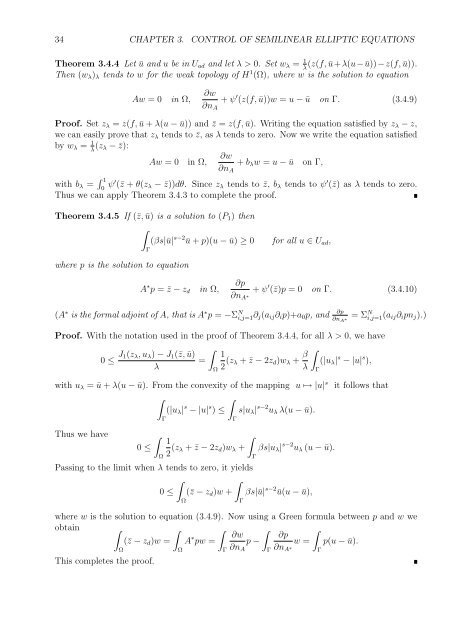Optimal Control of Partial Differential Equations
Optimal Control of Partial Differential Equations
Optimal Control of Partial Differential Equations
You also want an ePaper? Increase the reach of your titles
YUMPU automatically turns print PDFs into web optimized ePapers that Google loves.
34 CHAPTER 3. CONTROL OF SEMILINEAR ELLIPTIC EQUATIONS<br />
Theorem 3.4.4 Let ū and u be in Uad and let λ > 0. Set wλ = 1 (z(f, ū+λ(u−ū))−z(f, ū)).<br />
λ<br />
Then (wλ)λ tends to w for the weak topology <strong>of</strong> H1 (Ω), where w is the solution to equation<br />
Aw = 0 in Ω,<br />
∂w<br />
+ ψ<br />
∂nA<br />
′ (z(f, ū))w = u − ū on Γ. (3.4.9)<br />
Pro<strong>of</strong>. Set zλ = z(f, ū + λ(u − ū)) and ¯z = z(f, ū). Writing the equation satisfied by zλ − z,<br />
we can easily prove that zλ tends to ¯z, as λ tends to zero. Now we write the equation satisfied<br />
by wλ = 1<br />
λ (zλ − ¯z):<br />
∂w<br />
Aw = 0 in Ω, + bλw = u − ū on Γ,<br />
∂nA<br />
with bλ = 1<br />
0 ψ′ (¯z + θ(zλ − ¯z))dθ. Since zλ tends to ¯z, bλ tends to ψ ′ (¯z) as λ tends to zero.<br />
Thus we can apply Theorem 3.4.3 to complete the pro<strong>of</strong>.<br />
Theorem 3.4.5 If (¯z, ū) is a solution to (P1) then<br />
<br />
(βs|ū| s−2 ū + p)(u − ū) ≥ 0 for all u ∈ Uad,<br />
where p is the solution to equation<br />
Γ<br />
A ∗ p = ¯z − zd in Ω,<br />
∂p<br />
∂nA ∗<br />
+ ψ ′ (¯z)p = 0 on Γ. (3.4.10)<br />
(A ∗ is the formal adjoint <strong>of</strong> A, that is A ∗ p = −Σ N i,j=1∂j(aij∂ip)+a0p, and ∂p<br />
∂n A ∗ = ΣN i,j=1(aij∂ipnj).)<br />
Pro<strong>of</strong>. With the notation used in the pro<strong>of</strong> <strong>of</strong> Theorem 3.4.4, for all λ > 0, we have<br />
0 ≤ J1(zλ,<br />
<br />
uλ) − J1(¯z, ū) 1<br />
=<br />
λ<br />
2 (zλ + ¯z − 2zd)wλ + β<br />
<br />
(|uλ|<br />
λ<br />
s − |u| s ),<br />
Ω<br />
with uλ = ū + λ(u − ū). From the convexity <strong>of</strong> the mapping u ↦→ |u| s it follows that<br />
<br />
(|uλ| s − |u| s <br />
) ≤ s|uλ| s−2 uλ λ(u − ū).<br />
Γ<br />
Thus we have<br />
<br />
1<br />
0 ≤<br />
Ω 2 (zλ<br />
<br />
+ ¯z − 2zd)wλ + βs|uλ|<br />
Γ<br />
s−2 uλ (u − ū).<br />
Passing to the limit when λ tends to zero, it yields<br />
<br />
<br />
0 ≤ (¯z − zd)w + βs|ū| s−2 ū(u − ū),<br />
Ω<br />
Γ<br />
where w is the solution to equation (3.4.9). Now using a Green formula between p and w we<br />
obtain <br />
<br />
(¯z − zd)w = A<br />
Ω<br />
Ω<br />
∗ <br />
∂w ∂p<br />
pw = p −<br />
Γ ∂nA Γ ∂nA∗ <br />
w = p(u − ū).<br />
Γ<br />
This completes the pro<strong>of</strong>.<br />
Γ<br />
Γ

















